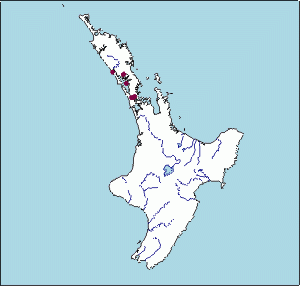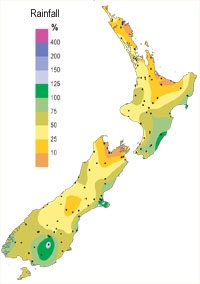PDF of this article (399 KB)

Anne-Maree Schwarz
A surprising amount of plant life inhabits coastal Antarctic waters beneath the sea ice. How can plants survive such uninviting conditions?
Marine plants need light in order to photosynthesise and grow. So what happens in an environment where there is no daylight for four months of the year, and for much of the rest of the time there is a thick covering of ice? These are the conditions faced by plants in Antarctic marine coastal waters. Nevertheless, these plants can grow well enough to help support a very rich array of benthic marine fauna (see “Assessing biodiversity”).
The amount of light that gets through the ice to the water below is a key influence on organisms living under persistent sea ice. This determines whether plants can photosynthesise, and consequently can affect the amount and type of food available for herbivores. Thus sea-ice affects both primary (plant) and secondary (animal) production. One of the main aims of NIWA’s coordinated research programme ICECUBE is to determine the relationships between sea ice and the composition and functioning of benthic communities. This article describes some of the linkages between ice-cover, underwater light and primary production that have been investigated so far under the ICECUBE project. Most of this work has been undertaken at Cape Evans on Ross Island (see Ross Island map).
Plant life in Antarctica
Plant life in Antarctic coastal ecosystems falls into four main groups: phytoplankton, sea-ice and seafloor micro-algae (such as single-celled diatoms), and macroalgae (seaweeds). Each has a characteristic relationship with the environment.
In the water column there are seasonal cycles in phytoplankton production and populations can increase rapidly during the short summer.


The sea-ice provides a unique habitat with enough light and nutrients for the growth of high concentrations of micro-algae. These can be seen with the naked eye as a yellow-brown colour in the under side of the ice. When the ice melts the sea-ice algae fall to the seafloor. Here they may form food for small grazers, and this way they are incorporated into the food web of the seafloor.
Where there is a suitably stable substrate (e.g., rocks) and enough light (dependent on ice characteristics, water clarity and water depth), we find micro-algae and macroalgae living on the seafloor.
One interesting feature of our study site at Cape Evans is the relatively abundant seaweed growth on the rocky seafloor. In contrast, no seaweeds grow in the soft sediments at New Harbour, which is at a similar latitude but on the continental side of McMurdo Sound. At Cape Evans, two kinds of seaweed with leafy fronds have been found, as well as a crustose coralline alga that coats the rocks. Their occurrence here is only slightly farther north than the extreme southern limit for seaweeds – Hut Point, also on Ross Island.
Little is known about the interactions between these seaweeds and other coastal marine plants and animals in the Ross Sea. One thing we do know is that the abundant sea urchins at Cape Evans do not graze on the common seaweed Phyllophora, though the urchins may carry fronds of the seaweed around on their spines.
Seaweeds often contribute to coastal ecosystems by providing habitat and releasing nutrients as the plant decays, rather than through direct grazing. For example, accumulations of detached, drifting fronds of Phyllophora at Cape Evans provide habitat for fauna such as worms and small crustaceans.
Efficient use of light
One topic we have investigated at Cape Evans is the mechanisms that enable seaweeds like Phyllophora to survive at such high latitudes. Antarctic seaweeds are well adapted to photosynthesise and grow at low water temperatures, but they cannot survive if there is not enough light for photosynthesis. McMurdo Sound (latitude 77–78°S) is in complete darkness for four months of the year, and at Cape Evans ice-cover may persist all year or may break up for just a few months in summer.

So just how much light is there? From December 2001 to November 2002 we used loggers to make regular measurements of the light underwater at depths where the seaweeds live. We also measured how much light was needed for photosynthesis and growth. An example of the data is shown in the graph . In December 2001 when divers put the loggers in position, Cape Evans was covered by ice. There was so little light at that time that growth was not possible. In fact, we suspect that at this time plants were still using stored reserves to meet their metabolic needs.
On the last day of January, when ice-breakout occurred at the site, underwater irradiance increased 100 times – the start of the short window of time when there is enough light for growth. However the next year’s ice began to form again in late March. Underwater light levels quickly dropped, and by late April winter darkness had again taken over. No light was recorded again at this depth until late August.
The very short window of opportunity for growth means that, in order to persist, seaweeds at Cape Evans must have an extraordinary ability to utilise low light, to maximise production during the time when there is relatively high light, and to survive winter darkness. The results of our photosynthesis and growth experiments show that despite having these key survival attributes, the plants still require decades to grow to just a few tens of centimetres long.
Important interactions
The relationship between ice cover, light and production of seaweeds is just one example of the many interactions between physical and biological processes in coastal ecosystems that we are investigating under the ICECUBE project. We will extend the work to contrasting sites along the latitudinal gradient (see “Assessing biodiversity”) including sites investigated as part of the expedition on the research vessel Italica in 2004 (see “Voyage”). Our research will help to assess and predict any effects of future environmental change on coastal ecosystems in Antarctica, which are coming under increasing pressure not only from climate change, but also from fishing and tourism.
Teachers: this article can be used for NCEA Achievement Standards in Biology (1.2, 1.4, 1.7, 2.2, 2.5, 2.7, 3.2), Geography (1.7, 2.7, 3.7). See other curriculum connections at www.niwa.co.nz/pubs/wa/resources
Anne-Maree Schwarz is based at NIWA in Hamilton.
